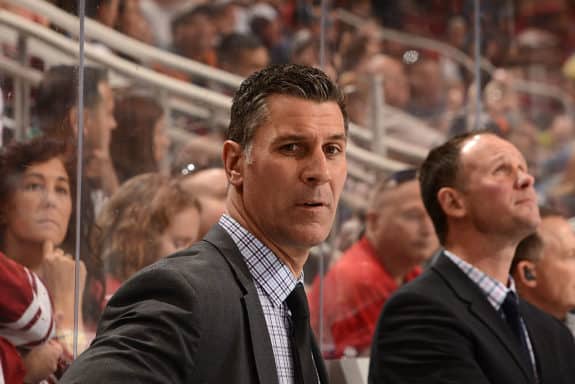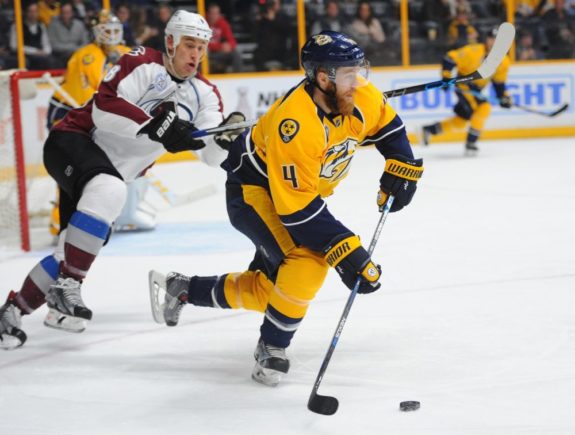The Colorado Avalanche roared back into hockey relevancy this past season, pummeling all expectations. Did they advance past the first round of the playoffs? No. But at the start of the season, the majority of opinions indicated Colorado would be basement dwellers yet again. The Avalanche had different ideas.
The Avalanche Buried Last Season’s Dismal Record
Colorado had a historically bad season last year, earning a paltry 48 points off a disappointing 22-56-4 record. Other fan bases could argue whether their team had a better home record or road record. Avalanche followers faced disappointment in both locales, with only 13 wins at home and nine on the road.
This season, the Avalanche nearly doubled last year’s point production, reaching 95 points for the season. Their record improved to a respectable 43-30-9, with 28 home wins and 15 road wins. The team even went on a historic 10-game winning streak.
Alternate captain Nathan MacKinnon rose to new heights, reaching a career-high 97 points off 39 goals and 58 assists, placing him fifth in NHL scoring, playing fewer games than all those above him. MacKinnon’s performance rocketed him to contention for the Hart Trophy as the NHL’s most valuable player. He made his second straight All-Star appearance. And he captured the attention of a fan base accustomed to disappointment.

MacKinnon didn’t reach such lofty heights on his own. Linemate Mikko Rantanen, in only his second year in the NHL, racked up 84 points while captain Gabriel Landeskog tallied 62 points, just three points shy of his career high from the last time the Avalanche qualified for the playoffs, four years ago.
The Avalanche as a whole came together to earn 41 regulation and overtime wins, tied for 12th place in the NHL. The team as a whole scored 255 goals, 10th in the NHL and 90 more than the previous season. Last season, the Avalanche owned the least effective power play in the league, successful only 12.6 percent of the time, while the penalty kill unit ranked 29th last year, successfully killing 76.6 percent of shorthanded situations.
The difference between years was like the difference between night and day. Colorado ranked eighth on the power play with a 21.9-percent success rate while the penalty kill climbed up to fourth place as the team killed 83.3 percent of shorthanded situations without allowing a goal. The Avalanche not only buried last season’s poor performance, they burned all remnants and let their energized play blow the dusty memories away.
The Avalanche Changed the Culture
By the end of last season, everyone was tired of losing. The team seemed to have a knack for finding a way to snatch defeat out of the jaws of potential victory. They continually found new ways to lose. And the team looked like a bunch of individuals just trying to survive, with no one really paying attention to their teammates.
The Avalanche initiated the culture change with substantial personnel changes. Coach Jared Bednar was able to hire his choices of assistant coaches. General manager Joe Sakic released a number of ageing veteran players and added pieces from both college hockey and a few experienced but younger players from other clubs. Bednar was now armed with the talent to help propel the team forward.

Colorado transformed into the youngest team in the NHL this year, icing 11 rookies over the course of the season. In November, Sakic finally traded away dissatisfied forward Matt Duchene in the blockbuster trade of the season. Among the return pieces, 19-year-old defenseman Sam Girard, who started with the big club and earned his spot on the blueline.
But the differences didn’t stop there. The new, younger Avalanche team developed a camaraderie that never existed in the old rendition. The players joked around with each other on the ice before trying to beat each other on drills. While all highly competitive, they also enjoyed each other, playing pranks and joking around.
Veteran defenseman Erik Johnson, who’s played eight seasons for the Avalanche, spoke about how he loved this team as the season ended. This group bore no resemblance to the crew from last year, even though nearly half of them played for Colorado last year.
The changes carried over to the disgruntled fan base. Avalanche fans had become jaded over the course of the past few years. Few expected the team to improve significantly and even fewer hoped for them to reach levels of respectability.
But the change in culture showed up on the ice. Halfway through the season, Avalanche fans started recognizing the change. More people started going to the Pepsi Center, and fewer opponents’ fans showed up. When fans from the opposing team started cheering, they were drowned out. Ticket sales started to recover. The culture change on the team became contagious and Avalanche shirts, jerseys, hats, etc. started permeating the city, even on non-game days. The team shifted and the fans started to believe.
The Avalanche Entered the Postseason Playing to Win
Colorado eked into the final wild-card spot for the playoffs the last day of the season in a do-or-die game against the St. Louis Blues. The winner would advance as the eighth seed in the playoffs while the loser would go home. The Avalanche roared through the game to emerge 5-2 victors. The Pepsi Center erupted – both on and off the ice. This was a different team, even from the group that played four years ago. And the fans knew it.
Being the eighth seed in the Western Conference, however, proved to be a mixed blessing. The Avalanche would have to play the best team from the regular season, the Presidents’ Trophy-winning Nashville Predators. The Preds ended the season with 117 points and were returning to the playoffs after making the Stanley Cup finals last year. Once again, the analysts underestimated the Avalanche, predicting an easy sweep for the Predators.

The Avalanche, though, surprised everyone but themselves. Even though they had been swept by the Predators in the regular season, the first two games in Nashville proved the team could keep pace with Nashville. They very nearly stole the second game, mounting a third-period comeback to come up one goal short.
When the Avalanche returned to Colorado, they did something completely unexpected. They took an early lead and defended it throughout the matchup, winning with a resounding 5-3 score. One could hear the shock from some national media. The fourth game at home showed the Avalanche mounting a comeback before falling goal short. While disappointing, those watching the team didn’t give up hope. Coach Bednar sent out a tweet that summed up what many were saying as the left Pepsi Center. Not only did the team believe in themselves, but now the fans believed in the team.
Walking out of Pepsi Center tonight, multiple employees finishing up their duties greeted me with “See you Sunday coach”. Love the positivity around the building and city. Supportive, All In.
— Jared Bednar (@BednarJared) April 19, 2018
The Avalanche made good on their promise to play to win, showcasing the real difference in Game 5. Colorado, not the strongest road team during the regular season, went into Nashville as severe underdogs. Both teams battled but remained scoreless through two periods, each side keeping pace with the other. The Predators finally broke through off a questionable call with 10 minutes remaining. The Avalanche roared back, scoring two goals in the last five minutes of the game to garner the win. Respect earned.
Unfortunately for the Avalanche, while they left it all out on the ice in Game 5, they didn’t seem to have much left in the tank for Game 6. Nashville swept through Colorado 5-0, their only easy win in the series. For the bubble team to keep pace with the Presidents’ Trophy winners, though, taking them to six games defied all expectations.
Not only did the Avalanche come through on their promise of exciting hockey, they ignited a disillusioned fan base and earned the respect of those who had dismissed them. Even coach Peter Laviolette of the Nashville Predators commended Colorado for their play and spoke highly of the Avalanche’s future.
The Avalanche not only pummeled their naysayers’ expectations, they smashed them. And being the youngest team in hockey means the future is bright. Time to buy some rose-colored glasses. The Avalanche built something special that should continue to grow and improve for years.